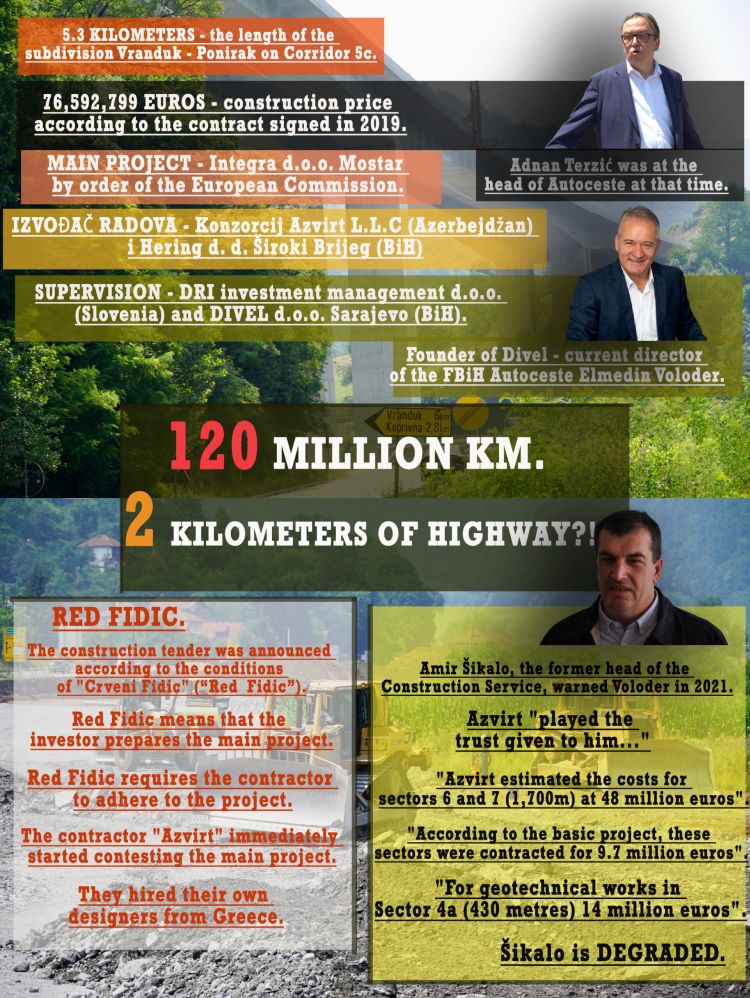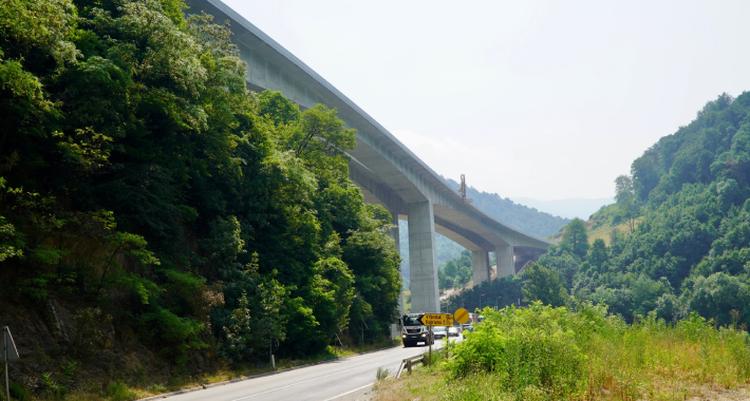
The 5.3-kilometre highway route was supposed to be completed last year. Fokus.ba is in possession of documentation that talks about the constant increase in the final price of the highway, even during the design process. What did Autoceste FBiH say for Fokus, and what did Adnan Terzić and the EU Delegation in BiH say?
The construction of the highway on Corridor 5c near Zenica, more precisely the 5.3-kilometre long Vranduk-Ponirak subdivision, has been at an impasse for some time, and the cause is, to put it mildly, murky actions, as evidenced by extensive documentation in the possession of the Fokus.ba portal.
The deadlines were well missed since this section was supposed to be completed in August last year. This is what the official information on the website of the Public Company Autoceste FBiH tells us, and the contractors caused a real explosion of costs, which is why additional loans were requested.
BY: AMIL DUČIĆ/FOKUS.BA
In recent days, as we have learned, insider information in the form of an official document was sent to the addresses of the State Investigation and Protection Agency (SIPA) and the Prosecutor's Office of BiH, among other things, describing, at the very least, unreasonable moves in the construction of this section, which is why organized criminogenic activities are suspected, such as falsification of documentation and other manipulations. It is emphasized that prices were deliberately inflated, that is, the costs of total activities in the sub-section, all in order to bring multimillion-dollar benefits to individuals. But let's start from the top.
The contract for the construction of the section Poprikuše – Zenica north (Donja Gračanica), whose subsection is Vranduk – Ponirak, was signed on May 15, 2019. The consortium Azvirt LLC (Azerbaijan) and Hering dd Široki Brijeg (BiH) was chosen as the contractor.
The supervision of the execution of the works is carried out by the consortium of DRI upravljanje investicij d.o.o. (Slovenia) – DIVEL d.o.o. Sarajevo (BiH).
By the way, the founder of Divel is the current director of the FBiH Autoceste Elmedin Voloder. The FBiH Government appointed him acting director in June 2021, and in April of this year, he received a full mandate in this position. Therefore, the supervision of this section is carried out by a company founded by the current director of Autoceste, which is the contracting authority and implementer of the project.
The value of the contract for the construction of the subdivision Vranduk – Ponirak was originally 76,592,799 euros including VAT, and the funds were provided through the OPEC Fund for International Development (OFID). According to the information from the last report on the European Union project from April this year, which Autoceste FBiH prepared for foreign creditors, due to the enormous escalation of costs, an additional debt of 25 million euros was requested for the Vranduk – Ponirak subdivision, from the previous creditor OFID.
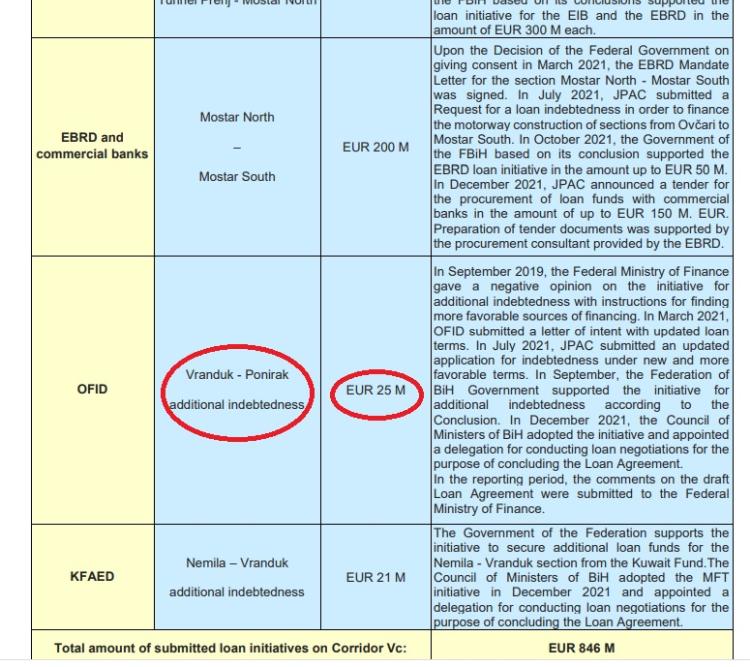
From the FBiH Autoceste report: Additional debt of 25 million euros
According to the latest available information, after the FBiH Government approved this assignment in September 2021, and the Council of Ministers adopted the initiative in December of that year and appointed a delegation to conduct negotiations on the loan, the draft contract was sent to the FBiH Ministry of Finance for further decision-making.
It is interesting, as stated in this report, that the Ministry of Finance of the FBiH has already given a negative opinion on additional borrowing in 2019. The note states that the costs of the works for this subsection were paid from Autoceste's own funds and that they will be reimbursed after the OFID loan comes into effect. This report also gives a very brief description of why the design and construction of the Vranduk – Ponirak subdivision was stalled, and it is stated that “different and new geological conditions” have occurred.
There is no more information for the public, but Fokus.ba has obtained relevant documentation signed by the responsible persons in the FBiH Autoceste responsible for the construction and other experts who were involved in this project, who we will name.
First of all, it should be emphasized that an integral part of the contract for the construction of this section was, among other things, the main project of the Knjiga A. Trasa route, which was created in 2017 by the company Integra d.o.o. Mostar. The aforementioned project documentation, which was submitted for implementation in JP Autoceste d.o.o. Mostar, was commissioned by the European Commission.
Adnan Terzić was at the head of Autoceste at that time. Autoceste then positively evaluated this project and the tender was announced according to the conditions of the “Fidic Crvena Knjiga” (“Fidic Red Book”). In practice, the Red Book or Red Fidic means that the investor must create the main project, which was done in this case, obtain building permits and fulfil a number of other prerequisites, and only then start issuing tenders for contractors.
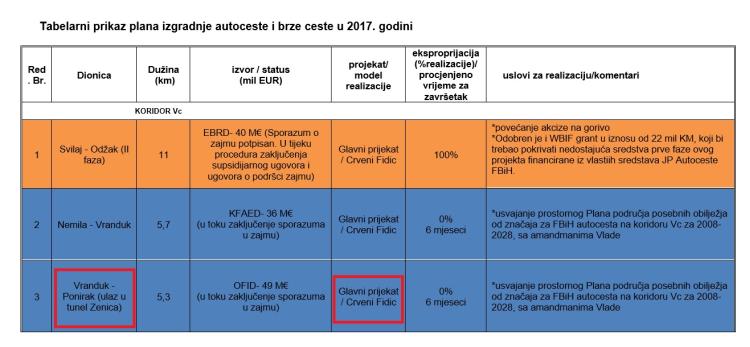
According to Red Fidic, the contractor adheres to the project documentation, which in the case of the construction of the Vranduk – Ponirak subdivision was by no means the case, because the contractor, Azvirt, who was in charge of the open part of the route (because Hering was working on viaducts), immediately started to dispute the main project and hired its own designers from Greece. So, at the start, there was a violation of the terms of the tender, which, let's note, was supported by Autoceste FBiH.
The Delegation of the European Union in Bosnia and Herzegovina told Fokus.ba that the technical documentation submitted to Autoceste was prepared and delivered by a consortium led by the company SPEA, of which Integra was a part, and approved by Autoceste FBiH.
– After the submitted technical documentation, the FBiH Autoceste did not apply for an investment grant within the Investment Framework for the Western Balkans (WBIF) for the financing of the Vranduk – Ponirak subsection. The decision to finance the construction of the Vranduk – Ponirak subdivision with loans from the OPEC Fund for International Development certainly made this project ineligible for financing under the European Investment Framework for the Western Balkans (WBIF). As the European Union is not involved in the financing of the construction of this subdivision, we do not have a mechanism to supervise, monitor or influence its construction, and therefore we cannot comment on allegations of irregularities in this project, but we call on the authorities to investigate any credible allegation of criminal acts – Ferdinand Koenig, spokesman of the EU Delegation in BiH, told Fokus.ba.

Koenig: We urge the authorities to investigate any credible allegation of wrongdoing
So, the then FBiH Autoceste Administration, led by Adnan Terzić, initially bypassed both EU grant funds and the European creditor, who normally, when they agree on the arrangements, retain the right to control the construction. They chose OPEC, which is backed by Saudi Arabia, Kuwait, Qatar and other members, which do not have such control mechanisms over the implementation of loans.
In September 2021, the then head of the Construction Service, Amir Šikalo, to the FBiH Autoceste Administration, then already headed by Voloder as acting director (he succeeded Terzić in June 2021), after official reports and opinions and consulting a number of experts, some of whom are distinguished professors, members supervisory teams, etcetera, sends alarming information in which it literally states that the contractor, that is Azvirt, “played the trust assigned to him for the redesign of large parts of the route of this subsection”. This document is owned by Fokus.
– In the G31 missions (geotechnical implementation study) of the contractor, reduced rock mass parameters and stricter calculation methods were applied compared to other construction sites – this led to the challenge of the solution from the main project, but also to an enormous escalation of costs of several tens of millions of euros. One gets the impression that in this way the contractor wanted to force changes to the project solutions and thus bypass the unit prices of the work positions from the basic contract and in this way gain a profit that does not belong to him. This is indicated by the fact that until now, and the basic deadline has already expired, the contractor has not even attempted to carry out any part of the works according to the basic project – warns Šikalo in his report to the Autoceste Administration.
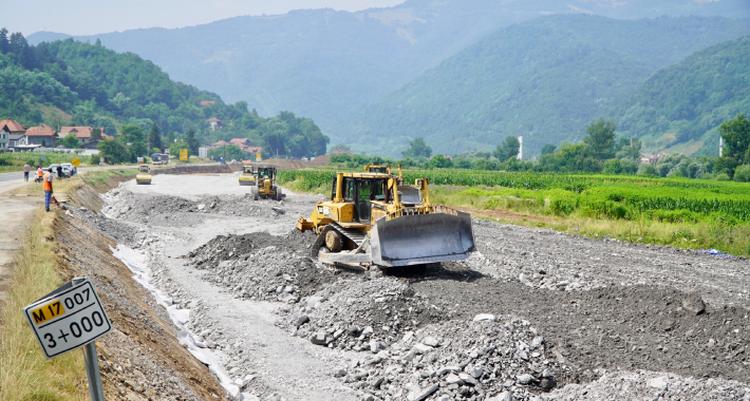
Works on the subdivision PHOTO: D. Begović
Furthermore, he states that in sector 4a of this route, “demonstrated in action is the contractor's strategy to use the project change to delegate new prices even for positions for which there is a similar replacement item in the project with its agreed price from the contract”. According to Šikalo, this is also contrary to the Decision of the Autoceste Administration, which ordered that when changing projects, positions and prices from the basic contract should be used wherever possible.
– Supervision (Divel and DRI) made an assessment of variation order no. 7 for geotechnical works in Sector 4a, which amount to about 14 million euros, of which 9.3 million euros have already been paid to the contractor (Azvirt), and it is about the length of the route of about 430 metres. There is no doubt that if the situation continues to develop in this direction, a similar escalation of costs is expected in other sectors of the open route – warns Šikalo.
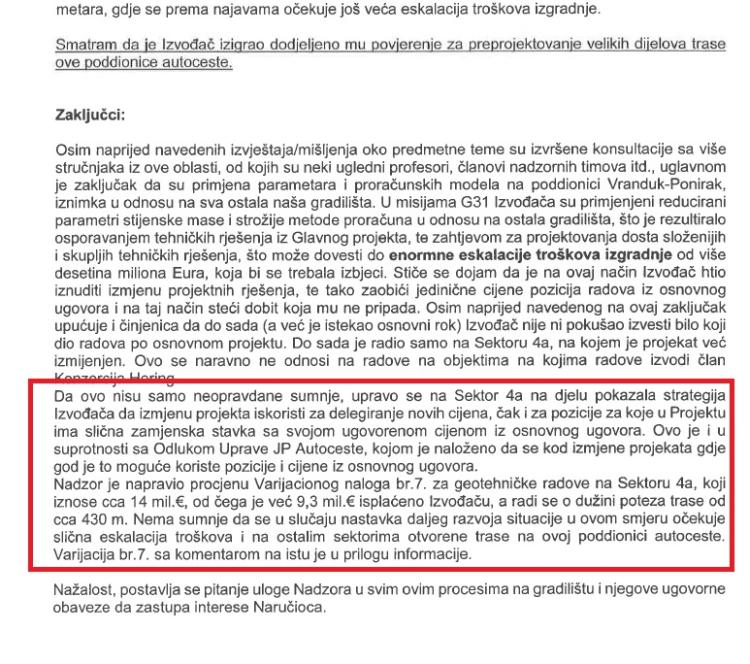
Part of Amir Šikal's letter
As he further states, the contractor, namely Azvirt, originally proposed four solutions for sectors 6 and 7 of this route. According to Šikalo, two of the four variants included tunnel variants despite all design reasons.
Later, he states, the contractor's designer proposed two variants – alternatives 8 and 9, which entailed changing the axis of the highway (moving away from the slope), which resulted in a drastic increase in the length of the viaduct with a drastic reduction in the amount of excavation and embankment. The first cost estimate that he submitted read: The construction of sectors 6 and 7 with a total length of 1,700 metres would amount to 69 million euros (according to alternative 8), or 67 million euros (according to alternative 9).
Šikalo reminds that the entire subdivision Vranduk – Ponirak, with a length of 5.3 kilometres, was contracted for 76 million euros, and according to his proposals, the contractor would spend 69 million euros only on 1,700 metres!
– Such a proposal with such an increase in construction costs led to doubts about the good intentions of the contractor, because it became obvious that all these new solutions aim to change the project one after the other in order to “bypass” the positions of works that include unit prices with “0 euros”. In addition to the large increase in the length of the viaduct, the type of span construction and foundation was also unnecessarily changed, which would introduce new positions with drastically higher prices compared to those already contracted for similar facilities on the route of this subsection of the highway – points out Šikalo.
Later, according to him, Azvirt made a new proposal for sectors 6 and 7 and estimated the construction costs in the amount of 48 million euros including VAT. For the sake of comparison, Šikalo points out, that according to the basic project, this part of the route was contracted for 9.7 million euros.
– Analyzing the price of the facilities per unit of measure according to the new proposal, we come to the conclusion that it is 1.5 times higher than the price of similar facilities according to the basic contract, which gives a difference between 2.5 and 3 million euros. The contractor introduced new items, which increased the price of the works several times. In the very end, he proposed the construction of a 90-meter long tunnel at a cost of 2.5 million euros. Since we are talking about a short section of the route in an undisturbed rock massif, it is unreasonable to build expensive portal structures when it can be solved by cutting, albeit relatively high, but on a short section – stresses Šikalo, who in this whole story plays the role of supervision, namely Divel and DRI, although DRI later withdrew from this whole story.
He then notes that “demolition of the main project was always attempted to be carried out on paper without even trying to implement it on the ground”.
In this letter, Šikalo suggests the Autoceste Administration provide support “to start and direct this project, which is currently in crisis, so that it is realized within reasonable limits, without agreeing to the contractor's attempts to secure a profit for himself that does not belong to him”. He suggests that a decision be made that the contractor amend the projects of sectors 1, 6 and 7 and that this task be returned to the designer (Integra) in accordance with his role.
In addition, Šikalo states that, if the contractor continues to avoid the performance of his contractual obligations on the construction of the open route, measures provided for in the contract will be taken – exclusion of part of the works, imposition of subcontractors, contractual fines, and etcetera. Šikalo dissected the statements of the contractor's designer regarding safety and the like and stated that more than 10 inclinometers were installed on the open route of the subdivision, which very precisely measure possible movements in the base soil, and none of them showed that such movements exist.
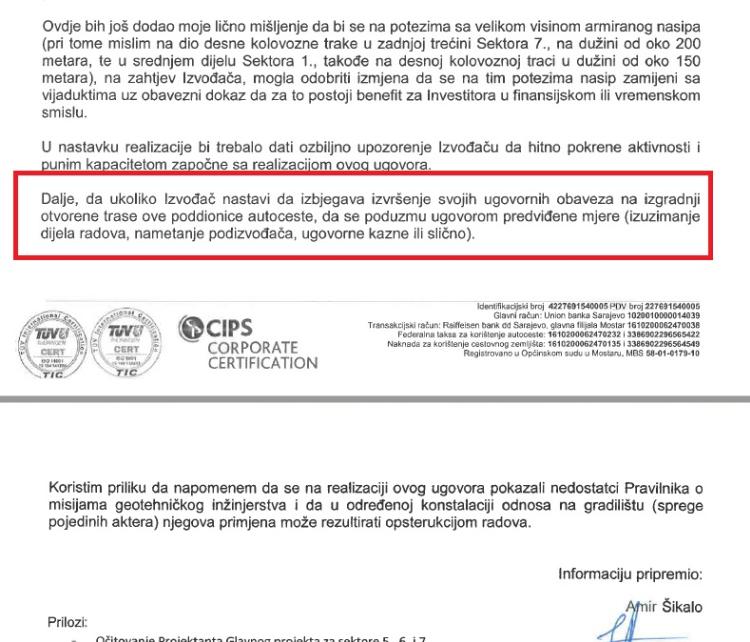
Facsimile of Amir Šikal's letter
Šikalo, who is no longer in this position, but in one of the lower-ranking ones, did not want to speak for Fokus, that is, to further elaborate on what he already wrote to the FBiH Autoceste Administration in September 2021.
However, the technical assistance, engaged by Autoceste FBiH, confirmed most of the basic statements of the designer, and Fokus.ba also obtained this document signed by Mato Uljarević, the current president of the Society for Geotechnics in Bosnia and Herzegovina. In short, this technical assistance disputed the missions of the G31 contractor stating that additional research and drilling were not carried out correctly, that the data obtained on the basis of additional wells were not correctly entered into the calculations, and that global stability, as claimed by the contractor, is not threatened nor that there is evidence for it.
Thus, in this document, which was created after a professional review of the documentation, many things are called into question: The question arises, considering the scope of the research works, whether it is justified. Was the program of additional research works (mission G31) made in an optimal way? It seems unjustified to apply the residual strength parameters and the disturbance factor of the geotechnical environment at the same time. The authors of the G31 mission did not take this into account (or at least did not show it in the submitted documentation) when performing and defining the safety factor of cuts on characteristic geotechnical profiles “secured” by some of the available subgrade systems defined by the main project (mission G21). The approach applied in mission G31 (selection of geoenvironmental parameters) included in geotechnical calculations is on the side of safety and it can be concluded that it will provide higher safety factors. But the question of need (justification) for this arises. Namely, this approach will increase the price of construction, which will be paid, without the need for it.
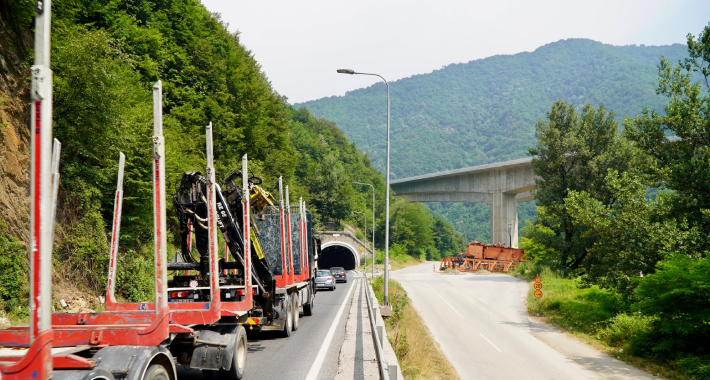
“There is not a single piece of physical evidence on the ground and in the excessive investigative work carried out” PHOTO: D. Begović
Uljarević confirmed for Fokus.ba that he stands behind the mentioned document and that there is nothing to add to it. Also, Fokus.ba came into possession of two designers’ opinions on the submitted documentation, for sectors 6 and 7 of this subdivision. It is about the acts of Integra, for which expert Enes Šerifović, a geological engineer from Tuzla, was hired. They also refute the contractor's documentation and question his geological findings.
– During the IG mapping of the open sections, not the slightest indication of faults or fault zones was found on the surface of the terrain. Upon inspection of the submitted documentation, “presumed faults” and “shear zones” were observed, for which there is not a shred of single physical evidence on the ground and in the excessive investigative works carried out. It is unclear on what basis the geotechnical models on which the stability analysis was made were created, given that they deviate from the engineering-geological profiles on which the types of rock mass (R0, R1, R2, R3) referred to by the G31 mission planner are not indicated. A non-transparent presentation of the stability analysis calculation where it is not possible to determine which parameters were adopted for the stability calculation. Observing the submitted documentation of the G31 mission, a “huge” effort is visible, however, the presentation of the research results is not standardized, to say the least, and is contradictory to previous geological knowledge and experiences – this is stated, among other things, in the findings of Professor Šerifović.

Facsimile of the Integra designer's document
Also, we are in possession of the report of the independent team of experts for geology and geotechnics of the Austrian company VCE – Vienna Consulting Engineers ZT Gmbh, which states, among other things: Taking into account the available information, it is not understandable why there should be fault zones and shear zones that are extended (sub)parallel to the route of the designed highway, which persist over 50 or 100 m and more, as shown in the cross-sections in the G31 mission documents.
Azvirt answered for Fokus.ba that, bearing in mind the contractual provisions on data confidentiality between Azvirt LLC and JP Autoceste as contractual parties, as a contractor they do not have the possibility to exchange information about the project with third parties, and that we should direct questions to JP Autoceste, which we certainly did.
In response to Fokus’ inquiry, Autoceste FBiH assessed as speculative the claims that the technical documentation was changed by the contractor (Azvirt) to the detriment of the client (Autoceste FBiH).
– Although the authors never provided any exact proof for their claims, the new management considered that the accusations went too far and created distrust in the public, which can have negative consequences for the project, so it annulled the decision of the old management and returned the design to its jurisdiction investors and hired a new company to design. After the selection of a new designer, the ongoing design began. All disinformation about the escalation of costs based on changes in project solutions by the contractor, which currently do not exist de facto, has been put ad acta. It is important to clarify that the escalation of costs has not yet occurred because the contract was signed without the main project of the route, so the agreed price was not even realistic. The price of the project will be known only when the new main project of the route is completed, and the method of calculation will be done in accordance with the Agreement and the law – emphasized FBiH Autoceste.
As they further state, when the new Autoceste Administration came in, they started moving. First of all, as they underline, the allegations of technical assistance and Šikala were taken very seriously, so in connection with the claims of escalation of costs, unjustified payment to the contractor and incorrect evaluation of variation orders and incorrect calculation of costs, Autoceste, in accordance with the Agreement and the law, turned to the next legal instance, the Dispute Resolution Board (DAB) already named in the Agreement from the FIDIC List of Adjudicators.
– The DAB has undoubtedly established that all calculations were made in accordance with the Agreement and the law, thus rejecting the accusations from Šikal and technical assistance in this matter as unfounded. Therefore, we underline that prices, or variation orders, are valued exclusively according to legal and contractual procedures. The Autoceste management did not and could not make a decision on the method of calculation, because that would be in violation of the Law on Obligations and the Law on Corridor 5c – claim Autoceste.
Answering several of our questions, they first pointed out that the documentation submitted by the European Commission, according to the level of processing, does not represent the main project of the route, as our legislation prescribes. Second, as they claim, for the implementation of the contract according to the FIDIC Red Book, it is necessary for the project to be completed to the level of the main project, which, they say, did not happen.
– Due to the difficult location access, the designer (Integra) did not perform investigative work on the site of the future route, as required by law, but it was only at the beginning of construction that it was established that the input data for the main geotechnical project were taken from other locations, so the entire main project of the route was carried out on wrong input parameters. The section in question is extremely steep and covered by dense forest, and the only approach could be implemented only after clearing the forest and creating access roads to the bore locations, which was not implemented in the design phase. The designer himself subsequently stated that he could not access certain localities. This means that it is clear that the investigative works placed in the main project were not from the location of the route – they point out from Autoceste FBiH.
Responding to our inquiry about the violation of the Red Fidic and about changes to the project, they stated: The solutions that were given as the main project of the route were not elaborated to the level provided by law for the main project, which is the necessary level of processing according to the terms of the Contract Red FIDIC 1999. Therefore, it was not we are talking about changes, but about the fact that the existing project documentation has not been done in the scope that represents the legal regulation.
Also, they point out that the auditor of the geotechnical project – mission G21 is the same legal entity (IG Banja Luka) that was later in the role of technical assistance during the implementation of the project. It was only in the role of technical assistance, as they state, that all these failures from the G21 mission were noted without assuming any responsibility for the audit phase.
– The head of the construction service (Amir Šikalo), whose responsibility was to review the technical documentation before the tender for execution, did not warn the then Autoceste Administration about the insufficiency of the documentation. On the basis of such deficient documentation, the JPAC Management signed two contracts for execution according to the terms of the FIDIC Red Book Contract in 1999. As soon as the execution of the works on the Vranduk – Ponirak section began, it was established that the main geotechnical project – mission G21, which was carried out by the designer, was not done in accordance with the law. For this reason, it was decided that the contractor, during the creation of the G31 mission (which is his legal obligation), will also do additional exploratory wells. The result of the investigative works is a drastically changed engineering-geological picture of the terrain from the one shown in the basic project – they pointed out.
As they point out, a drastic example can be seen in sector 4a, where the basic project on that part shows a soil cover at a height of 6-7 m, while in reality a potential landslide with an approximate depth of 30 m has been identified – for easier visualization, it is about the height of an average building of 10 floors.
Fokus.ba also contacted Adnan Terzić in order to hear his position on everything, since for a large part of the flow of activities related to the Vranduk – Ponirak subsection, he was at the head of the FBiH Autoceste. Terzić points out for our portal that right from the start it became clear, with regard to the slopes above the M-17 highway, that no geo-investigation work had been done.
– That complete project was not valid, that is, the project that was donated to us by the European Commission. Before me, Autoceste had a conceptual solution for that route that went down to the Bosna River and went in the direction of Doboj on the right side around the Vranduk tunnel. The European Commission took that conceptual solution. However, there were certain uprisings of the population on that route, so they raised the direction of the route to a higher level, to a mountain route, and thus the price of the subsection for which OFID had already given money went up. When we saw that the price had increased by several tens of millions, we went to their headquarters, they said that it was not a problem to allocate additional funds, but then the Ministry of Finance said that it was not acceptable, etcetera – stated Terzić.
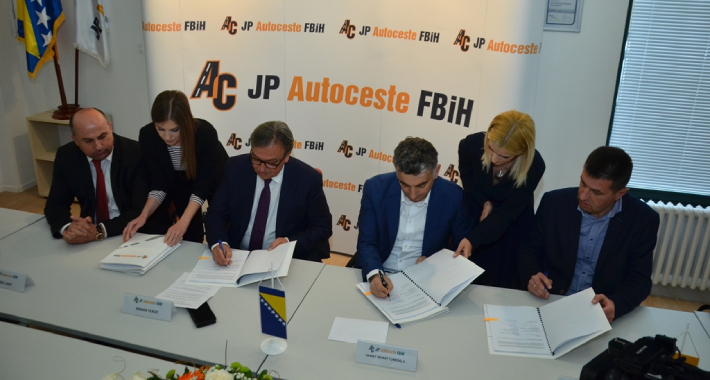
Terzić: Around that time when it was unravelling, my mandate expired
He points out that Azvirt had to remove a lot of things from the inaccessible terrain in order to carry out geo-investigation works, which, as Terzić claims, says a lot about the fact that the designer did not do it.
– We let Integra be the project supervisor because it participated in the consortium that designed it. Integra was offered to make an additional project, based on the geo-investigation work done by the contractor. They said they didn't have the capacity, and they didn't want to. In the end, the engineers, Šikalo and the supervisor agreed that we should not go for new tenders, which would stop the work, that the contractor should do it, and that the designers they choose should provide conceptual solutions for our commissions to accept, of course on the basis of geology. Therefore, to speed up the work – Terzić points out.
He also states that he encountered certain unprofessional behaviour there since they received eight solutions, after which, he says, they gathered a group of experts in geology and geotechnics, among others from the Faculty of Civil Engineering in Sarajevo.
– Somewhere around that time when it was unravelling, my mandate expired, and then Voloder came to the head of Autoceste – Terzić pointed out.
We also asked him how he comments on Integra's opinions drawn up by geologist Enes Šerifović, in which much is questioned about what was done by the designer hired by the contractor.
– Integra is lying. They defended their own, but for that one geologist, you have a team of geologists we hired who say otherwise – he said.
When asked why Autoceste did not apply for an investment grant from the EU, Terzić says because that section was not financed by the EU.
– The money given by the EIB or the EBRD can hardly be mined as a grant. WBIF only follows European money. They do not monitor commercial loans, but only those based on a state guarantee – he said.
